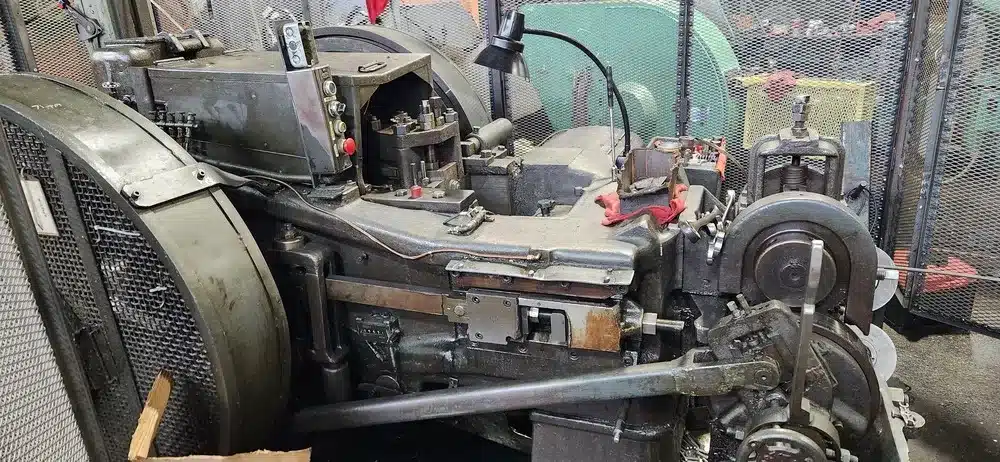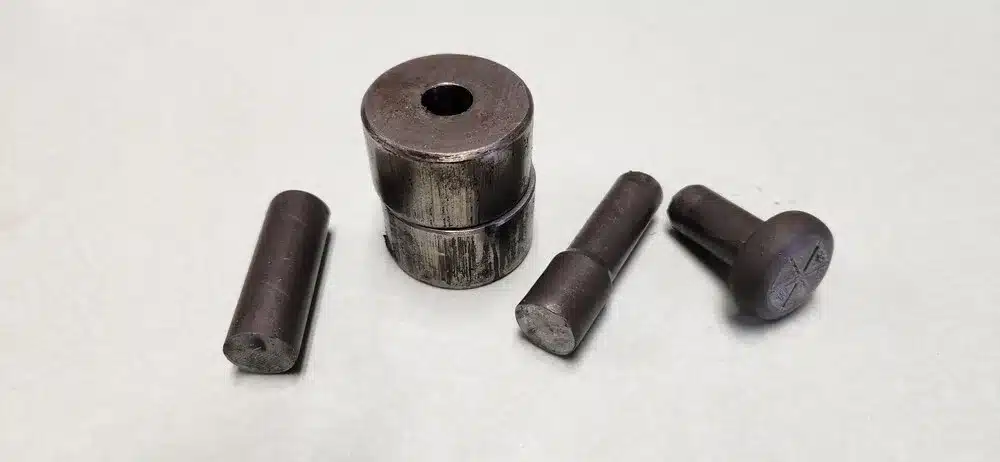One method of manufacturing steel fasteners stands out for its efficiency, precision, and cost-effectiveness: cold forming. This technique involves shaping metal through force alone, without additional heat or cutting processes.
At Wilson-Garner, we’re proud to utilize this technique to produce high-quality carbon steel and alloy fasteners. We know all the ins and outs of cold forming and are here to give you the inside scoop.
What Is Cold Forming?
Cold forming, also called cold heading, is a common manufacturing process that produces steel bolts and fasteners. Unlike methods that involve heating the steel, cold forming achieves shaping without using high temperatures. Instead, it relies on applying force through striking or pressing steel within a die, ultimately sculpting the metal into the desired dimensions.
Compared to alternative manufacturing methods such as hot forging and machining, cold forming stands out for its ability to bolster strength and minimize waste. Hot forging reduces waste and has fewer size and shape limitations, but it doesn’t enhance strength to the same degree as cold forming. Machining, on the other hand, excels in producing complex shapes but generates significant waste and may compromise the strength of the final product.
What Are the Key Benefits of Cold Forming?
Cold forming offers many advantages that ensure high-quality, reliable products.
1. Enhanced Strength Through Work Hardening
Cold forming can significantly bolster the strength of bolts and fasteners. This is achieved through a process called work hardening, where the steel is meticulously shaped without the need for cutting or heating. As a result, the grain structure of the steel remains intact and seamlessly flows with the contours of the part, contributing to increased strength and durability.
2. Elimination of Scrap and Material Savings
While traditional manufacturing methods can result in considerable material waste, cold forming minimizes scrap and promotes efficient material usage. By shaping the material into the desired form without removing any material, cold forming drastically reduces waste, leading to substantial material savings and cost reductions.
3. Dimensional Accuracy and Part Consistency
Cold forming helps meet stringent quality standards with precision. The process allows for the creation of fasteners with uniform dimensions and exact specifications, ensuring reliable performance and compatibility across various applications.
4. Improved Surface Finish and Reduced Secondary Operations
The precise shaping achieved through cold forming results in smooth surfaces and clean edges, eliminating the need for time-consuming secondary operations like polishing or grinding. This saves time and resources and enhances the aesthetic appeal of the final product.
What Parts Are Made by Utilizing Cold Forming?
Cold forming can be used to create a wide array of essential parts across various industries.
- Fasteners – Bolts, screws, studs, nuts, and rivets for many different industries are among the primary components manufactured through cold forming.
- Electronic housings and electrical contacts – The precision and accuracy offered by cold forming make it ideal for shaping electronic housings and electrical contacts, ensuring seamless functionality in electronic devices and systems.
From medical devices to aerospace components to consumer products, cold forming thrives when it comes to producing small parts. However, it’s also important to note its versatility in handling larger components.
At Wilson-Garner, our presses enable us to cold form parts with diameters up to 1-1/8″, showcasing the breadth of possibilities this manufacturing process offers.
Cold forming isn’t just limited to standard shapes and configurations. It also enables the creation of intricate designs and features, including the following:
- Threads – Cold forming facilitates the creation of precise threads, ensuring seamless integration with mating components and enhancing the overall integrity of assemblies.
- Knurls, heads, chamfers, grooves, tapers, and undercuts – Whether it’s adding texture for improved grip or incorporating specialized features for enhanced functionality, cold forming allows for the precise shaping of various details to meet specific requirements.
Discover How Wilson-Garner Utilizes Cold Forming
We’ve embraced cold forming at Wilson-Garner for manufacturing carbon steel and alloy steel fasteners. This technique aligns perfectly with our commitment to delivering superior quality, precision, and reliability.
By utilizing cold forming, we ensure that our fasteners exhibit exceptional strength, dimensional accuracy, and consistency. The process enhances the structural integrity of our products through work hardening, where the steel’s grain structure remains intact, resulting in unparalleled durability and reliability.
Our cold-formed fasteners are used for applications across a diverse range of industries, including but not limited to the following:
- Automotive industry – Automotive manufacturers trust our cold-formed fasteners for engine components, suspension systems, and chassis assemblies.
- Military Ground Vehicles – Our cold-formed fasteners play a vital role in military ground vehicle construction and maintenance. They meet the rigorous demands of these applications, contributing to the safety and performance of military vehicles.
- Heavy machinery – With their exceptional strength and reliability, our fasteners contribute to the effectiveness and safety of heavy machinery, ensuring reliable performance in various industrial applications worldwide.
Contact Wilson-Garner for Exceptional Fastening Solutions
Contact us today to learn more about our innovative manufacturing processes, extensive product offerings, and how we can meet your needs and requirements. Whether you’re in the military, automotive, heavy machinery, or any other industry, trust Wilson-Garner to deliver reliable, high-quality fasteners that exceed your expectations.

